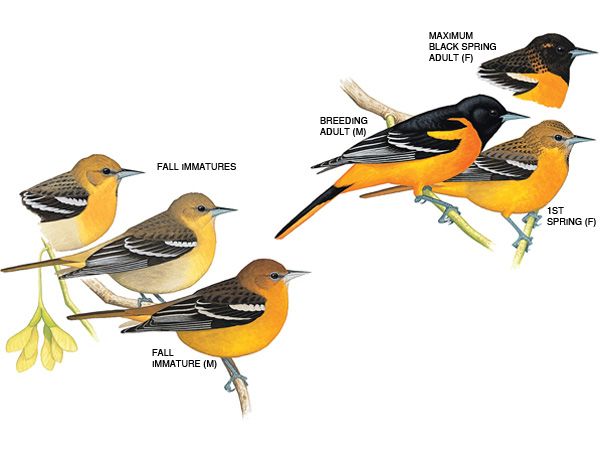Identification of Baltimore Oriole Female & Male
Baltimore oriole ‘Icterus galbula’ is a transatlantic vagrant. It is a medium-sized 19-20 cm in length, rather slim passerine with a fair long, sharply pointed bill. Baltimore Oriole adult male a startlingly bright orange and blackbird, with black head, mantle and most of the wings and tail, bright orange underparts, rump, ‘shoulder patch’ and tail corners, and a whitish bar on greater coverts.
A small percentage of males have orange replaced by bright yellow. Unmistakable Baltimore oriole female and 1st-winter male are variably patterned, but all show double whitish wing bars and edges to tertials.
Many adult females are olive-brown above (brighter, more yellowish-olive, from rump to tail) and orange-yellow on the forehead. Most of the underparts (the strongest on breast and under tail coverts), often show some blackish mottling on the throat, head, and mantle.
But some are very dull with grayish-brown upperparts (brighter, more yellowish-olive, from rump to tail) and only a pale orange-yellow wash to underparts. While yet others are brighter orange on the head and underparts than typical individuals and some (perhaps older individuals) are heavily marked with blackish on the throat, head, and mantle.
Therefore, and so resemble a dull version of an adult male. Most birds recorded are in 1st-winter plumage (which closely resembles typical or duller variants of adult Baltimore Oriole female. In this plumage, double whitish wing bars and dull orange-yellow underparts, and tail underside are perhaps the most striking features of this canopy-feeding species.
The bill shape is also a useful clue to its identity, being slender but markedly conical and sharply pointed. The wing bars and bill shape are useful distinctions from the two tanagers which have occurred in our region. They are fed inside the foliage of the canopy and are often difficult to observe.

SEX/AGE
The juvenile lacks any black on the head and resembles the dullest adult females. 1st-winter male resembles the typical adult female but usually shows a contrast between darker (fresh) greater coverts and paler brown flight feathers and primary coverts. It appears almost like an adult male in 1st-summer plumage (but shows the variable amount of olive in upper parts and dull brown flight feathers and primary coverts).
The 1st-winter female closely resembles duller adult females, but it lacks the blackish mottling on the head, throat, and mantle shown by some latter.
VOICE
Baltimore oriole voice is migrant’s typically silent, but calls include a low, fluting ‘hew-li’ and a rattling ‘cher-r-r-r-r-r’ of alarm. Moreover, both sexes sing a staccato chatter call during aggressive encounters, that can be heard at any time of the day.
SONG
Baltimore oriole song is a musical, fluting but somewhat disjointed series of ‘hew-li’ and other notes. Also in the breeding season, some oriole males give a flutter-drum sound to each other by beating their wings stridently in flight.
TAXONOMY
This species was known as Northern Oriole during the relatively short period when the western North American form bullockii (Bullock’s Oriole) was treated as conspecific: the two forms are now once more considered to be separate species.
HABITAT
Baltimore oriole is a vagrant in Western Europe. However, in the natural range, it is found in open woodland, groves, and parks.







